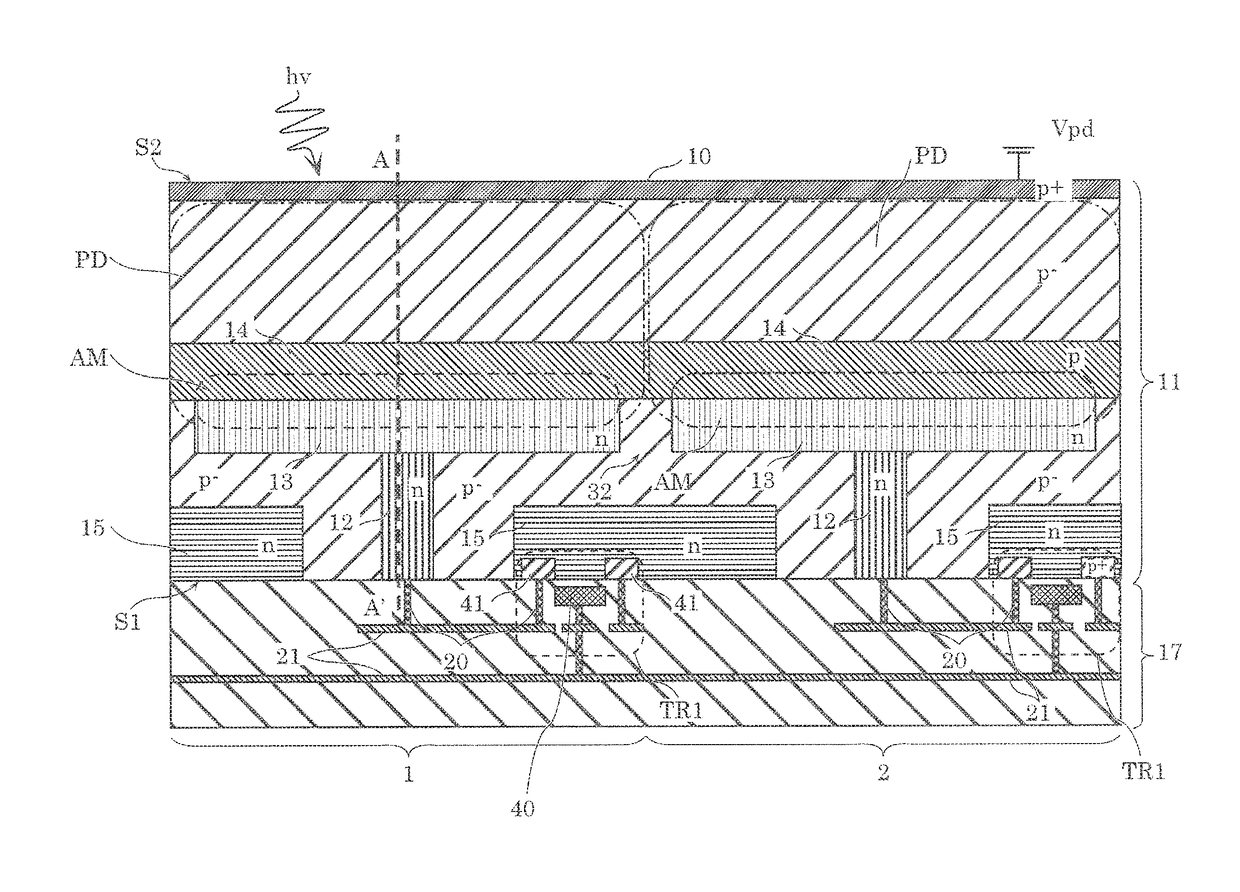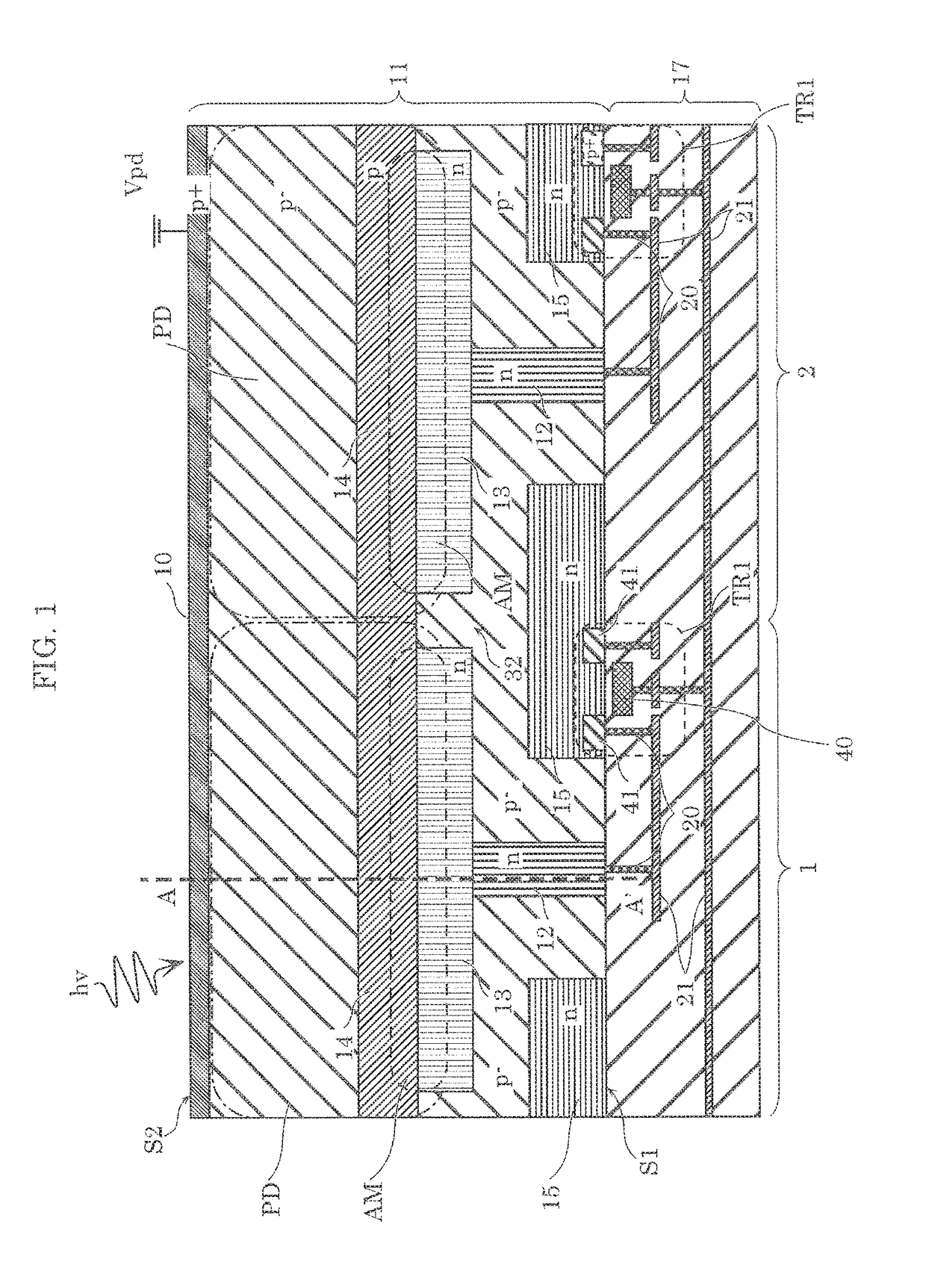Solid-state imaging device
- Summary
- Abstract
- Description
- Claims
- Application Information
AI Technical Summary
Benefits of technology
Problems solved by technology
Method used
Image
Examples
embodiment 1
[0029]First, a structure of a solid-state imaging device according to Embodiment 1 will be described with reference to FIG. 1 and FIG. 2. Note that, in the present specification, “planar view” indicates a view in the direction normal to first principal surface S1 and second principal surface S2 shown in FIG. 1.
[0030]FIG. 1 is a cross-sectional view of a pixel array (here, pixel 1 and pixel 2) included in a solid-state imaging device in the case where transistor TR1 is a P channel transistor. FIG. 2 is a plan view of first principal surface S1 of FIG. 1, which is seen in the direction of second principal surface S2. FIG. 2 also illustrates gate electrodes 40 of transistors TR1 for better understanding of the positional relationships. FIG. 3 is a graph showing a potential gradient at A-A′ line in FIG. 1, when fixed potential Vpd is applied to P+ type semiconductor region 10. Note that, when simply a “transistor” is referred to in the present embodiment, this means that the transistor ...
embodiment 2
[0052]Next, a structure of a solid-state imaging device according to Embodiment 2 is described with reference to FIG. 6. FIG. 6 is a cross-sectional view of the solid-state imaging device according to Embodiment 2 in the case where transistor TR1 is an N channel transistor. FIG. 7 is a plan view of first principal surface S1 in FIG. 6, which is viewed in the direction of second principal surface S2. FIG. 7 also illustrates gate electrodes 40 of the transistors for better understanding of the positional relationships.
[0053]In this case, it is necessary to form P type well 22 in each N type well 15. P type well 22 is another example of the first well region for forming transistor TR1. Even at the time of the avalanche multiplication driving, the potential of P type well 22 should be fixed to determine the voltage for driving the N channel transistor TR1. In order to achieve this, since P+ type semiconductor region 10 to which fixed potential Vpd is applied needs to be electrically iso...
embodiment 3
[0060]FIG. 8 is a cross-sectional view of a solid-state imaging device according to Embodiment 3. FIG. 9 is a plan view of first principal surface S1 in FIG. 8, which is viewed in the direction of second principal surface S2. FIG. 9 also illustrates gate electrodes 40 of the transistors for better understanding of the positional relationships. FIG. 10 is a plan view when the cross-section taken along line A-A′ of FIG. 8 is viewed in the direction of second principal surface S2. FIG. 11 is a plan view when the cross-section taken along line B-B′ of FIG. 8 is viewed in the direction of second principal surface S2. FIG. 12 is a graph showing the potential gradient at C-C′ line of FIG. 8 when fixed potential Vpd is applied to P+ type semiconductor region 10. In FIG. 8 to FIG. 12, elements that are essentially the same as Embodiment 1 share like reference signs. Moreover, the following description will focus on the points different from Embodiment 1.
[0061]Between N type semiconductor reg...
PUM
 Login to View More
Login to View More Abstract
Description
Claims
Application Information
 Login to View More
Login to View More - R&D
- Intellectual Property
- Life Sciences
- Materials
- Tech Scout
- Unparalleled Data Quality
- Higher Quality Content
- 60% Fewer Hallucinations
Browse by: Latest US Patents, China's latest patents, Technical Efficacy Thesaurus, Application Domain, Technology Topic, Popular Technical Reports.
© 2025 PatSnap. All rights reserved.Legal|Privacy policy|Modern Slavery Act Transparency Statement|Sitemap|About US| Contact US: help@patsnap.com



